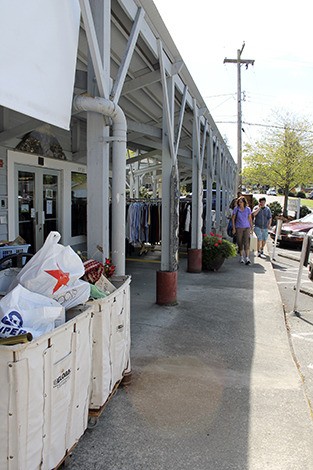The Mercer Island Thrift Shop makes money because it relies on volunteers to do everything from sorting donations to stocking shelves and more.
But over the last few months, some volunteers have left, and the store has suffered.
The implications of the trend are serious as the city begins plans to sell bonds to expand the Thrift Shop.
City Finance Director Chip Corder noted that the impact of the decline in sales, of course, is what will happen to plans to expand the shop, which provides revenues for Mercer Island Youth and Family Services programs.
The use of unpaid labor is key.
“The success of the thrift store is based on volunteers,” Corder said.
Not only do community volunteers spend countless hours at the store, but many students — many who are work-study students — are important to keeping the shop a success as well.
Thrift store coordinator Suzanne Philen said that the “human piece of running the store is very dynamic.”
Over time, older volunteers “age out,” she said. And now, work-study or student volunteers are becoming harder to find.
“Some cuts to state funding have limited work-study students,” Philen said. “And it has been harder to get students to leave campus and come here.”
As for the impact from the federal government shutdown, just one student is paid with federal money, she said. The student will continue to be paid, however, and the city will be reimbursed.
Materials prepared for the Mercer Island City Council detail the decline.
“The Thrift Shop’s double digit revenue growth through June 30, 2013, pulled back significantly in July and August, due to several unforeseeable factors unique to a retail community business that relies on volunteer and work study students for staffing: 1) an inability to recruit work-study students; 2) reduction in the amount of hours from the volunteer core; and 3) expanding store hours, assuming there would be no staffing issues in terms of work-study students and volunteers.”
Corder said that the shop grossed $1.22 million in 2012. The store is now projected to bring in somewhat less, about $1.32 million, he said.
It is still a good deal of money, he added, but it is less than what they forecast as they planned for the expansion.
The City Council will assess and decide to go ahead with the financing on Nov. 18. Corder hopes to be able to sell bonds for the project while interest rates are still relatively low.
Thrift Shop sales in 2013 started out strong in the first quarter, exceeding the proposed sales goals with an increase of more than 22 percent over last year. Second quarter revenues, while up by nearly 12 percent over 2012, were negatively affected by gradual attrition of work-study staff coverage along with the decrease in hours from several key members of the volunteer core. Work-study hours decreased from an average of 260 per week in the fall of 2012 to a low of approximately 124 hours per week in spring/summer 2013. Other temporary casual labor was hired at a higher cost.
Historically, the Thrift Shop encounters seasonal recruitment and retention patterns that allow for an increase in summer staffing. That was not possible this year, the report to the Council said.
The expansion of store hours to include Sundays also coincided with the decrease in the work-study staff and the reduction in core volunteer hours.
Both Corder and Philen believe that the decline and loss of volunteers is temporary. Shop management staff are currently working hard to address the staffing shortfall and to re-establish the balance of components needed to drive sales and to meet the numbers required to make the expansion project financially feasible.


